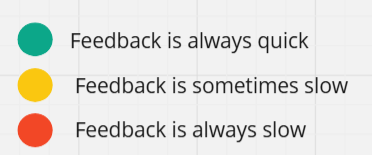Fast Feedback Workshop

This workshop is a way to understand the speed of the feedback in you software development process.
Overview of template
To run this workshop you need a diagram of the development process that your team follow. A sample template that you can modify to match your process can be found here:
Each block in the template is a task that occurs in the process. Each solid line represents a move to the another stage of the process, whilst the dotted lines represent a feedback loop in the process.
There are some coloured dots that can be used to represent the speed of the feedback loops

And finally there are some coloured blue boxes that can be used as additional notes to add anything that impacts the speed of the feedback loops that may not be covered in the process diagram.
Process
Book meetings with each member of your team individually. This is important as doing it as a group may encourage people to go along with the crowd and not voice their own honest opinions.
Each meeting should be no-more than 15 minutes
During the meeting run through the template and ask whether the feedback is always quick, sometimes slow or always slow.
If they are not directly involved in the part of the process then their feedback is perceived and if it is perceived then the corresponding dot should go inside the feedback loop box

If they are directly involved in the part of the process, then their feedback is actual and if it is actual then the corresponding dot should go on the dotted feedback line

It is important to capture the perceived feedback as this can help discover any misunderstandings. For example the engineering manager may think that the feedback is slow but actually when you speak to others on the team that particular feedback loop is as quick as it can be.
If there are additional notes add these to the blue boxes above the process
During a sprint ceremony add something in that could be improved or something to celebrate
Once you have spoken to everyone on the team you now need to act on that feedback. To do this, pick both positive (fast feedback loops or positive comments) as well as the negative (slow feedback loops and negative comments) and bring one of them into one of the teams ceremonies. In the ceremony the team can discuss how to improve a feedback loop they don’t do well, or celebrate a feedback loop that they do well. The important thing is to bring the feedback up in a sprint ceremony that already exists, for example the sprint retro. Try not to create a whole meeting just to go through all of the points from this workshop, as making it organic through using an existing sprint ceremony will increase the likelihood of improvement.